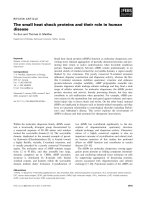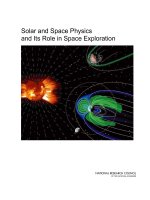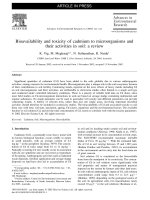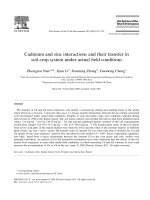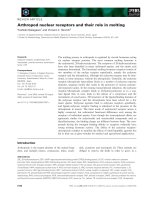- Trang chủ >>
- Khoa Học Tự Nhiên >>
- Vật lý
Seaweeds and their role in globally changing environments
Bạn đang xem bản rút gọn của tài liệu. Xem và tải ngay bản đầy đủ của tài liệu tại đây (8.99 MB, 465 trang )
SeaweedS and their role in Globally
ChanGinG environmentS
Cellular origin, life in extreme habitats and astrobiology
volume 15
Series Editor:
Joseph Seckbach
The Hebrew University of Jerusalem, Israel
For other titles published in this series, go to
www.springer.com/series/5775
Seaweeds and their role
in Globally Changing
environments
Edited by
alvaro israel
Israel Oceanographic and Limnological Research, Ltd.
The National Institute of Oceanography, P.O. Box 8030,
Tel Shikmona 31080. Haifa, Israel
rachel einav
Blue Ecosystems, 26 Hagat St., Zichron Yaakov, Israel
and
Joseph Seckbach
The Hebrew University of Jerusalem, Israel
Editors
alvaro israel
israel oceanographic and limnological
research, ltd.
the national institute of oceanography
P.o. box 8030, tel Shikmona 31080. haifa
israel
rachel einav
blue ecosystems
26 hagat Street
Zichron yaakov
israel
Joseph Seckbach
the hebrew University of Jerusalem
israel
iSbn 978-90-481-8568-9
e-iSbn 978-90-481-8569-6
doi 10.1007/978-90-481-8569-6
Springer dordrecht heidelberg london new york
library of Congress Control number: 2010925024
© Springer Science+business media b.v. 2010
no part of this work may be reproduced, stored in a retrieval system, or transmitted in any form or
by any means, electronic, mechanical, photocopying, microfilming, recording or otherwise, without
written permission from the Publisher, with the exception of any material supplied specifically for the
purpose of being entered and executed on a computer system, for exclusive use by the purchaser of
the work.
Printed on acid-free paper
Springer is part of Springer Science+business media (www.springer.com)
table of Contents
Preface/alvaro Israel and Rachel einav.............................................
ix
acknowledgements ..........................................................................
xiii
introduction/Joseph seckbach .........................................................
xv
list of authors and their addresses ...............................................
xxi
PaRt 1:
Changes In the MaRIne envIRonMent
Sea-level Changes in the mediterranean: Past, Present,
and Future – a review [lichter, M. et al.].................................
Global Climate Change and marine Conservation
[olsvig-Whittaker, l.] ................................................................
3
19
PaRt 2:
bIodIveRsIty In MaRIne eCosysteMs
In the globally ChangIng eRa
is Global warming involved in the Success of Seaweed
introductions in the mediterranean Sea?
[boudouresque, C.f. and verlaque, M.] .......................................
Climate Change effects on marine ecological Communities
[Rilov, g. and treves, h.] ...........................................................
Fucoid Flora of the rocky intertidal of the Canadian maritimes:
implications for the Future with rapid Climate Change
[Ugarte, R.a. et al.] ...................................................................
31
51
69
PaRt 3:
eCoPhysIologICal ResPonses of seaWeeds
GiS-based environmental analysis, remote Sensing,
and niche modeling of Seaweed Communities
[Pauly, K. and de Clerck, o.] .....................................................
v
93
vi
table oF ContentS
Physiological responses of Seaweeds to elevated
atmospheric Co2 Concentrations [Zou, d. and gao, K.] ...........
the role of rhodolith beds in the recruitment of invertebrate
Species from the Southwestern Gulf of California, méxico
[Riosmena-Rodriguez, R. and Medina-lópez, M.a.] ..................
the Potential impact of Climate Change on endophyte
infections in Kelp Sporophytes [eggert, a. et al.] ......................
115
127
139
PaRt 4:
the effeCts of Uv RadIatIon on seaWeeds
interactive effects of Uv radiation and nutrients
on ecophysiology: vulnerability and adaptation
to Climate Change [figueroa, f.l. and Korbee, n.] ....................
ecological and Physiological responses of macroalgae
to Solar and Uv radiation [gao, K. and Xu, J.] ........................
Ultraviolet radiation effects on macroalgae from Patagonia,
argentina [helbling, e.W. et al.] ................................................
157
183
199
PaRt 5:
bIofUel – seaWeeds as a soURCe
of fUtURe eneRgy
Production of biofuel by macroalgae with Preservation
of marine resources and environment [notoya, M.] ................
biofuel from algae – Salvation from Peak oil? [Rhodes, C.J.]..........
217
229
PaRt 6:
CUltIvatIon of seaWeeds In globally
ChangIng envIRonMents
a review of Kappaphycus Farming: Prospects and Constraints
[hayashi, l. et al.] .....................................................................
recycling of the Seaweed wakame through degradation
by halotolerant bacteria [tang, J.-C. et al.] ..............................
Progressive development of new marine
environments: imta (integrated multi-trophic
aquaculture) Production [Issar, a.s. and neori, a.]....................
reproductive Processes in red algal Genus Gracilaria
and impact of Climate Change [Mantri, v.a. et al.] ..................
the role of Porphyra in Sustainable Culture Systems:
Physiology and applications [Pereira, R. and yarish, C.] ...........
251
285
305
319
339
table oF ContentS
vii
PaRt 7:
bIoteChnologICal PotentIal of seaWeeds
intensive Sea weed aquaculture: a Potent Solution
against Global warming [turan, g. and neori, a.] ...................
the Future is Green: on the biotechnological
Potential of Green algae [Reisser, W.] .......................................
the Potential of Caulerpa spp. for biotechnological
and Pharmacological applications
[Cavas, l. and Pohnert, g.] ........................................................
357
373
385
PaRt 8:
otheR vIeWs to global Change
ecology, Science, and religion [Klostermaier, K.K.] .........................
nature and resource Conservation as value-assessment
reflections on theology and ethics [Roth, h.J.] .......................
Global warming according to Jewish law:
three Circles of reference [glicksberg, s.e.] ............................
Guarding the Globe: a Jewish approach
to Global warming [Rozenson, y.] ..............................................
449
organism index ..............................................................................
461
Subject index ..................................................................................
467
author index ..................................................................................
479
401
423
435
PRefaCe
alvaRo IsRael1 and RaChel eInav2
1
Israel Oceanographic and Limnological Research, Ltd. The
National Institute of Oceanography, P.O. Box 8030, Tel Shikmona
31080. Haifa, Israel. 2Blue-Ecosystems, 26 Hagat St., Zichron
Yaakov, Israel
Climate changes and global warming occurring on earth are now a widely
recognized phenomena within the public and scientific communities. they will
likely modify marine life dramatically as we now know it. one critical question
regarding these changes is whether they occurred because of human intervention, or due to natural events on earth, or a combination of both. irrespective
of the source of these changes, it is our responsibility to understand and properly control these events so as to diminish potential or irreversible damage in
the marine environment. the goal of this project, Seaweeds and Their Role in
Globally Changing Environments was to emphasize the role of marine macroalgae, the so-called seaweeds, within the context of global changes occurring on
planet earth.
this book concentrates on the diverse aspects of the expected effects of
global changes on seaweeds. First, a general overview of current changes in
the oceans is given including the legal aspects associated with these modifications. while responses to global changes occur first on a species level, ultimately the modifications will arise on a community and global ecosystem
levels. these aspects are discussed in Part 2. then, Part 3 addresses short- and
long-term seaweed ecophysiological responses to environmental abrupt
changes, which forces marine plants to make sudden adjustments rather than
adaptation processes that have occurred during millions of years of evolution.
Specific and detailed aspects of seaweed responses to the Uv rays are given in
Part 4. applied aspects of seaweeds follow in Parts 5 and 6. here, the reader
will find insights of potential uses of seaweeds in the future, and expected
effects on seaweed cultivation practices worldwide as dictated by the globally
occurring changes in the marine environment. theoretical approaches of
marine plants utilization in the future as related to modified environments are
shown in Part 7. Global changes influence almost all aspects of human life,
becoming daily worries/issues within the general public and scientific community. the need to enroll synergistic forces to address the problems derived
from global changes and their environmental effects is apparent. therefore,
we have considered pertinent to also include spiritual/religious approaches to
ix
x
PreFaCe
the issue, which are quite unique in the scientific literature. these aspects are
analyzed towards the end of the book and may allow to those readers interested in such aspects of life as well.
the book begins with rather pessimistic overviews of anthropogenic and
natural effects on the marine environment. although predictions may be quite
devastating, contributions presented by experts show much optimistic pictures
of how the marine macroalgae will look like in terms of their ecological communities and adaptation strategies. Further, seaweeds will have a much more
significant role in controlling environmental stresses caused by global change.
thus, the reader will be transferred through various levels of comprehension
both scientifically and encouragingly as to how will seaweeds be viewed in the
near future.
biodata of alvaro Israel and Rachel einav, editors of “Seaweeds and Their Role
in Globally Changing Environments”
dr. alvaro Israel is currently a Senior Scientist at the israel oceanographic and
limnological research, ltd., the national institute of oceanography, haifa,
israel (www.ocean.org.il). he obtained his Ph.d. from tel aviv University in 1992
in marine botany in carbon fixation aspects of seaweeds. then, he continued his
studies and research in environmental biology of plants and algae at UCla, USa.
dr. israel’s scientific interests are in the area of seaweed eco-physiology, global
change and applied phycology. recent scientific activities of his work include
describing the effects of elevated Co2 in photosynthesis of marine macroalgae and
developing biological background for seaweed cultivation in land-based settings.
e-mail:
dr. Rachel einav is Ceo of blue ecosystems (www.blue-ecosystems.com), a company providing marine environmental consulting. She obtained her Ph.d. from
bielefeld University (Germany) in eco-physiology and adaptation strategies of
marine macroalgae. results of her post-doc project at bar ilan University (ramat
Gan, israel) were published as a book – Seaweeds of the Eastern Mediterranean
Coast, (in hebrew, and in english by a. r. G. Ganther verlag K. G. (india) now
being translated to arabic. dr. einav scientific interests are in the area of marine
environment and anthropogenic effects on seaweed communities.
e-mail:
alvaro Israel
Rachel einav
aCKnoWledgMents
we are grateful to all the authors of this project for their patience and understanding during the making of the book. we also wish to thank the reviewers
involved in the evaluation of the chapters, particularly dr. amir neori and
dr. linda whittaker, and to Guy Paz for preparing the illustration of the cover.
this project was supported by research Grant no. iS 3853-06 r from bard,
the USa–israel binational agricultural research and development Fund.
xiii
IntRodUCtIon to globally ChangIng envIRonMent
JosePh seCKbaCh
Hebrew University of Jerusalem, Israel
1. Weather Changes in the Past
archeological evidence for weather changes in the past are seen in the discovery of
traces of agriculture and tropical plants (bones and fossils) in desert areas. other
evidence demonstrates the inundation of settlements that today are beneath the sea.
Finding marine traces and fossils at high altitudes, such as hill tops, and in other dry
zones climate changes supports this assumption. Some scholars have assumed that
global warming during the biblical noah’s generation may have caused the flood.
others view the egyptian atmospheric plagues toward the exodus of the children of
israel and the splitting of the red Sea as related to climate change by nature.
the release of current industrial pollution and other sources into the atmosphere and hydrosphere has increased at a far greater rate than any historic natural
process. one serious regional environmental problem is acid rain. as long as we
have been burning fossil fuels, this acidic liquid has been falling from the sky and
causing damages.
even with the biological removal of pollution caused by Co2, which also
causes atmospheric warming, the pre-existing state cannot be regained precisely.
So, global warming is accelerating faster than the ability for natural repair. lately,
it has been determined that there is no link between global warming and cosmic
rays or other solar activities.
2. Current human activities and their Influence on the Climate Changes
a new naSa-led study shows that human-caused climate change has made
an impact on a wide range of earth’s natural systems, resulting in permafrost
thawing, acid rain, plants blooming earlier across europe, and lakes declining in
productivity. researchers have linked varying forces since 1970 with rises in temperatures. humans are influencing climate through increasing greenhouse gases
emissions, among them are Co2, n2o, Ch4, CF3, and CFC. Global warming is
influencing physical and biological systems all over our planet but most specifically in north america, europe, asia, and antarctica.
Climate change is one of the greatest challenges the world is now facing.
leaders should now deal with this disaster by calling for long-term international
development programs. the ecology factors driven by man include industrial fuel
xv
xvi
introdUCtion to Globally ChanGinG environment
burning that yields by-products and pollution spills, vehicle emissions, smoke
from power stations’ chimneys, huge fires, and other harmful environmental
activities. all those occurrences may intensify the greenhouse effect, cause
changes to climate, and directly harm global biology. Further damage caused by
man includes deforestation in some developing areas. the felling of millions of
trees in areas like the amazon rain forest in addition to forest fires will reduce the
green lungs of the globe. likewise, damage could result from excess grazing by
herds, excess pumping of water, and desertification. Some gases (such as CFC)
released by industrial activities damage the protective screen of the stratospheric
ozone layer (as, e.g., the recently discovered ozone holes over antarctica) and
cause intensive Uv radiation to penetrate to earth in higher doses.
Some predictions claim that with global warming we shall have less rain and
less precipitation. or, rain will arrive in short, strong storms, so that the precipitation will not penetrate into the subsurface accumulation spaces. Such an effect
would reduce and damage the subsurface water reservoirs. others see no rain,
drought, the drying out of large water supplies, dust storms on a great scale, and
general damage to agriculture. all these will damage more and more genera of
living creatures. there are also contrasting harmful effects, such as heavy rains
and floods, or hurricanes in certain zones around the globe; intensified and ruinous damage from storms; thawing of glaciers; and the rise of sea levels, with the
danger of over flooding to low lands.
the rise in temperature will influence the evaporation rates in lakes (see the
current case of the drying dead Sea [israel], Chad lake [africa], or aral lake [in
asia]), which might shrink and almost vanish without sufficient income of water
from their sources. Global warming also poses a severe danger for some animals,
such as, the polar bear that is in danger of extinction, or the harm caused by the
expansion of fire ants to areas once too cold for them. warmer and more acidic
oceanic water (due to the increase of Co2 in the atmosphere and oceans) spells
trouble for jumbo squids and other marine animals. Global warming might cause
a reduction in the amount of dissolved oxygen in the oceans and lead to suffocation of marine biota. results, for example, would be that the tuna and sword fish
would turn into extinct species and corals would be harmed, resulting in the disappearance of several species of fish and reefs.
trees in western north america are dying more quickly than they used to,
but there is no corresponding increase in the number of new seedling trees.
mortality rates, which are currently of the order of 1% a year, have in many cases
doubled in just a few decades. the increased mortality correlates with climate
change in the region, which has warmed by an average of between 0.3°C and
0.4°C per decade since the 1970s.
Some experts claim that even if carbon emissions were stopped, temperatures around the globe would remain high until at least the year 3000. and if we
continue with our current carbon dioxide discharge for just a few more decades,
we could see permanent “dust bowl” conditions.
introdUCtion to Globally ChanGinG environment
xvii
3. What should be done to Curtail human actions that Promote
global Warming?
the responsibility of the community is to avoid desertification and repair it. there
should be a shift to growing crops which need less irrigation, and the burning of
large amounts of fossil crude oils and coal should be avoided by using alternative
energy sources. nations should carefully manage the consumption of fuel by the
various vehicles (cars, boats, air planes, and power stations). they should maintain restrictions on deforestation and seek alternative sources of usable water (for
human needs and agricultures).
4. algae, seaweeds, and global Warming
microalgae and seaweeds (see further) have enormous potential and are actively
involved in lowering global warming and climate change. algae and seaweeds (like
the entire green world) absorb carbon dioxide from the atmosphere (or directly
from their solution media) by the process of photosynthesis, release oxygen, and
produce solar biofuel. during photosynthesis algae (and higher plants) grow; they
actually drain Co2 from the atmosphere. this gas is released again when their
biomass burns. this Co2-capturing system within the green world keeps this gas
from re-entering the air (except for minor amounts released during the plant–
animal respiration process). in fact, even the plant residue (e.g., the ashes) could
be put to good use as mineral-rich fertilizer after being pressed into biofuel.
marine macroalgae (seaweeds) play significant roles in the normal functioning of atmospheric environments. even though seaweeds are restricted to the tide
zones and benthic photic zones, they contribute to about 10% of the total world
marine productivity. ecologically they account for food and shelter for marine
life. Seaweeds are also used as sea-vegetables for food consumption (for fish and
man). in the Far eastern countries they use Porphyra blades (nori) in cuisine. in
addition, elsewhere other edible seaweeds are in use, such as Rodymenia (dulse),
Laminaria saccharina, Chodrus, and Ulva (sea lettuce). there are other uses
for seaweed since it is rich in vitamins, minerals, and proteins. various marine
macroalgae are potential sources of bioactive compounds, and they act as antibacterial and antiviral agents. among them are those that may also be utilized for
the treatment of human diseases such as cancer.
Globally changing environments on earth is more likely to severely modify
the current equilibrated terrestrial and marine ecosystems. Specifically for the
marine environment, global changes will include increased carbon dioxide which
will acidify the aqueous media. it has been estimated that for Co2, the change
might be from the current 350 ppm to approximately 750 ppm within 50 years, or
so. Such a difference will cause higher average seawater temperatures (within
1–3°C) and higher Uv radiation on the water surface. these changes will affect
marine macroalgae at different levels, namely molecular, biochemical, and
xviii
introdUCtion to Globally ChanGinG environment
population levels. while predictions of altered environments have been studied
extensively for terrestrial ecosystems, comparatively much less effort has been
devoted to marine habitat. Seaweeds may contribute significantly to reduce
pollutants (such as Co2, heavy metals, and excessive nutrients disposed of in the
marine environments).
5. What should be done to Reduce greenhouse gas emission?
5.1. no need For redUCinG the GreenhoUSe eFFeCt – FalSe
PaniC alarm
historic records extracted from deep ice cores (taken in antarctica drilling) show
that quantities of Co2 have varied widely in the last hundreds or thousands of years.
this evidence appears to contradict the current critical view of global warming.
Some voices claim that the present observation of the human-induced greenhouse
effect is actually a natural occurrence. they say that the effect of carbon on the climate is overestimated and the climate crisis might be hyped. however, a new study
shows that although carbon dioxide levels may have been larger in the past, the
natural processes had time to react and counteract global warming.
5.2. do it now
only good education and international enforcement applied to governments will
reduce the pollution in our planet. the less greenhouse gases released to the atmosphere and hydrosphere (by various human sources), the greater and faster will be
the salvation to the problem of global warming.
6. Conclusion and summary
there are pro and con arguments about global warming and its damage to the earth’s
atmosphere. as a result of continuing pollution, we might witness the warming of
the atmosphere, changes in the precipitation, and an increase of the Co2 level in
the atmosphere which might also cause acidification of the oceans. the elevated
temperature causes the thawing and melting of the glaciers, which will raise the sea
level and cause overflooding overfloating and drown the nether areas (under the sea
level). other hazards are the lowering of ground water and the salting of the aquifers near the sea shores, reducing drinking water and agricultural irrigation, desertification of large green areas, and increasing doses of Uv harmful irradiation.
activities should be designed to prevent most of the dangerous phenomena
noted above; one such possible endeavor would be the search for an alternative
energy source (rather than black gold or coal). a main target is utilization of
introdUCtion to Globally ChanGinG environment
xix
alternative sources of energy, such as solar and wind energy, hydroelectric power,
and “ocean energy” (using underwater vibration) for various human applications.
these powers should reduce and avoid the spread of harmful gases. in some
cases, the use of uranium could also be implemented as an energy source, but this
means must be instituted very cautiously. another aspect is a stricter watch over
fires, and the maintenance and increase of the areas of rain forests. but above all
is the education of the present and future generations to keep our mother earth
as pure as possible.
biodata of Joseph seckbach, co-editor of this volume and author of “Introduction
to Globally Changing Environment”
Professor Joseph seckbach is the Founder and Chief editor of Cellular Origins,
Life in Extreme Habitats and Astrobiology (“Cole”) book series and is the
author of several chapters in this series. See www.springer.com/sereis/5775. dr.
Seckbach earned his Ph.d. from the University of Chicago, Chicago, il (1965) in
biological sciences. among his publications are books, scientific articles concerning plant ferritin (phytoferritin), cellular evolution, acidothermophilic algae, and
life in extreme environments. he also edited and translated several popular books.
dr. Seckbach is the co-author (with r. ikan) of the Chemistry Lexicon (1991,
1999, hebrew edition) and other volumes, such as the Proceeding of Endocytobiology VII Conference (Freiburg, Germany, 1998) and the Proceedings of Algae
and Extreme Environments Meeting (trebon, Czech republic, 2000); see:http://
www.schweizerbart.de/pubs/books/bo/novahedwig-051012300-desc.ht). his new
volume entitled Divine Action and Natural Selection: Science, Faith, and Evolution,
has been edited with Professor richard Gordon and published by world Scientific
Publishing Company.
e-mail:
lIst of aUthoRs foR “SEawEEdS and ThEIR RolE
In Globally ChanGInG EnvIRonmEnTS”
bleICheR-ChonneUR genevIeve
raw materialS ProCUrement, CarGill textUriZinG
SolUtionS, baUPte 50500, FranCe.
boUdoUResqUe ChaRles f.
Center oF oCeanoloGy oF marSeilleS CamPUS oF lUminy,
UniverSity oF the mediterranean, 13288 marSeilleS
Cedex 9, FranCe.
Cavas levent
diviSion oF bioChemiStry, dePartment oF ChemiStry,
FaCUlty oF artS and SCienCeS, doKUZ eylül UniverSity,
İZmir 35160, tUrKey.
CRaIgIe JaMes s.
aCadian SeaPlantS limited, 30 brown avenUe, dartmoUth,
b3b1x8, nova SCotia, Canada and national reSearCh
CoUnCil oF Canada, inStitUte For marine bioSCienCeS,
1411 oxFord Street, haliFax, b3h 3Z1, nS, Canada.
CRItChley alan t.
aCadian SeaPlantS limited, 30 brown avenUe, dartmoUth,
b3b1x8, nS, Canada.
de CleRCK olIvIeR
PhyColoGy reSearCh GroUP, bioloGy dePartment,
Ghent UniverSity, Ghent 9000, belGiUm.
eggeRt anJa
PhySiCal oCeanoGraPhy and inStrUmentation,
leibniZ inStitUte For baltiC Sea reSearCh warnemünde,
roStoCK 18119, Germany.
eInav RaChel
blUe eCoSyStemS, 26 haGat St., ZiChron yaaKov 30900,
iSrael.
xxi
xxii
liSt oF aUthorS
fIgUeRoa félIX l.
dePartment oF eColoGy, FaCUlty oF SCienCe, UniverSity
oF málaGa, 29071 málaGa, SPain.
gao KUnshan
State Key laboratory oF marine environmental SCienCe,
xiamen UniverSity, xiamen, 361005, China.
glICKsbeRg shloMo e.
eFrata ColleGe oF edUCation, ben yiFUneh 17, baKa’a,
JerUSalem 91102, iSrael.
hädeR donat-P.
FriedriCh-alexander UniverSität erlanGen/nürnberG,
dePartment oF bioloGy, StaUdtStr. 5, erlanGen 91058,
Germany.
hayashI leIla
dePto. beG, Centro de CiÊnCiaS biolÓGiCaS, UniverSidade
Fedral de Santa Catarina, trindade, FlorianÓPoliS,
Santa Catarina 88040-900, braZil.
helblIng e. WalteR
eStaCiÓn de FotobioloGía Playa UniÓn, CaSilla de
CorreoS nº 15, (9103) rawSon, ChUbUt and ConSeJo naCional
de inveStiGaCioneS CientíFiCaS y téCniCaS, ConiCet,
arGentina.
hURtado anICIa q.
SoUtheaSt aSian FiSherieS develoPment Center,
tiGbaUan, iloilo 5021, PhiliPPineS.
IsRael alvaRo
iSrael oCeanoGraPhiC & limnoloGiCal reSearCh, ltd.,
the national inStitUte oF oCeanoGraPhy, P.o. box 8030,
haiFa 31080, iSrael.
IssaR aRIe s.
ben GUrion UniverSity oF the neGev, J. blaUStein
inStitUte For deSert reSearCh, ZUCKerman inStitUte
For water reSoUrCeS, Sede boKer CamPUS 84990, iSrael.
liSt oF aUthorS
xxiii
Jha bhavanath
diSCiPline oF marine bioteChnoloGy and eColoGy,
Central Salt and marine ChemiCalS reSearCh inStitUte,
CoUnCil oF SCientiFiC and indUStrial reSearCh (CSir),
bhavnaGar 364002, india.
KleIn MICha
dePartment oF GeoGraPhy and environmental StUdieS,
UniverSity oF haiFa, haiFa 31905, iSrael.
KlosteRMaIeR KlaUs K.
dePartment oF reliGion, UniverSity oF manitoba,
winniPeG mb, r3t 2n2 Canada.
KoRbee nathalIe
dePartment oF eColoGy, FaCUlty oF SCienCe,
UniverSity oF málaGa, 29071 málaGa, SPain.
KüPPeR fRIthJof C.
SCottiSh aSSoCiation oF marine SCienCe, oban,
arGyll Pa37 1Qa, SCotland, UK.
lIChteR MIChal
“CoaStS at riSK and Sea-level riSe” reSearCh GroUP,
the FUtUre oCean exCellenCe ClUSter, inStitUte oF
GeoGraPhy, ChriStian albreChtS UniverSity, Kiel 24098,
Germany.
MantRI vaIbhav a.
diSCiPline oF marine bioteChnoloGy and eColoGy,
Central Salt and marine ChemiCalS reSearCh inStitUte,
CoUnCil oF SCientiFiC and indUStrial reSearCh (CSir),
bhavnaGar 364002, india.
MedIna-lóPeZ MaRCo a.
ProGrama de inveStiGaCiÓn en botániCa marina,
dePartmento de bioloGia marina, UniverSidad
aUtonoma de baJa CaliFornia SUr aPPartado PoStal 19-b,
laPaZ b.C.S 23080, mexiCo.
xxiv
liSt oF aUthorS
MasUya floWeR e.
inStitUte oF marine SCienCe, UniverSity oF dar eS
Salaam, P.o. box 668, ZanZibar, tanZania.
nagata shInIChI
environmental bioChemiStry diviSion, reSearCh Center
For inland SeaS, orGaniZation oF advanCed SCienCe and
teChnoloGy, Kobe UniverSity, Kobe 658-0022, JaPan.
neoRI aMIR
iSrael oCeanoGraPhiC & limnoloGiCal reSearCh ltd,
national Center For mariCUltUre, P.o. box 1212,
eilat 88112, iSrael.
notoya MasahIRo
notoya reSearCh inStitUte oF aPPlied PhyColoGy,
mUKoJima-4, SUmida-KU, toKyo 131-8505, JaPan.
olsvIg-WhIttaKeR lInda
SCienCe and ConServation diviSion, iSrael natUre and
national ParKS ProteCtion aUthority, 3 am ve olamo St,
Givat ShaUl, JerUSalem 95463, iSrael.
PaUly Klaas
PhyColoGy reSearCh GroUP, bioloGy dePartment, Ghent
UniverSity, Ghent 9000, belGiUm.
PeReIRa RUI
Ciimar/Cimar, Centre For marine and environmental
reSearCh, rUa doS braGaS, 289, Porto, PortUGal.
PeteRs aKIRa f.
beZhin roSKo, 29680 roSCoFF, FranCe.
PohneRt geoRg
inStitUte For inorGaniC and analytiCal ChemiStry,
FriedriCh SChiller UniverSity Jena, d-07743 Jena, Germany.
Reddy C.R.K.
diSCiPline oF marine bioteChnoloGy and eColoGy,
Central Salt and marine ChemiCalS reSearCh inStitUte,
CoUnCil oF SCientiFiC and indUStrial reSearCh (CSir),
bhavnaGar 364002, india.

